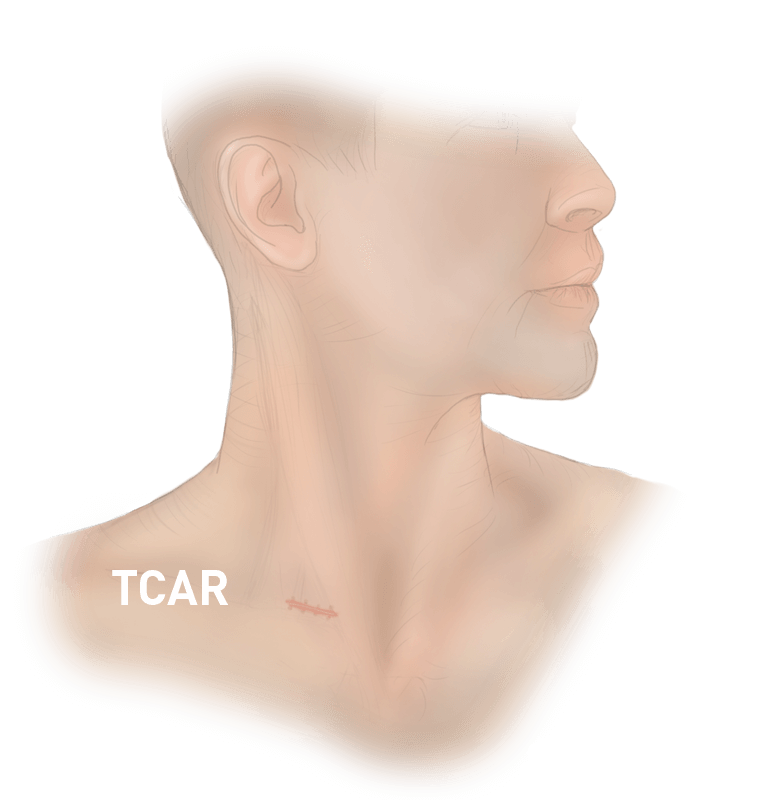Carotid Artery Disease
Carotid artery disease refers to a narrowing (stenosis) or blockage of the arteries in the neck that supply blood to the brain, often due to a buildup of fatty plaque inside the arteries. A severe enough blockage may lead to a stroke, sometimes called a “brain attack,” or temporary symptoms called a mini-stroke or transient ischemic attack (TIA), either due to a reduction in the blood supply carrying oxygen to the brain, or when bits of the plaque, or clot, break off and go to the brain. The presence of this plaque can be identified with a noninvasive carotid duplex scan performed in an accredited vascular laboratory.
Carotid Artery Disease Treatment: Why Choose Johns Hopkins
Treatment of carotid artery disease depends on a number of factors, including whether the patient has experienced symptoms; the patient’s age, overall health and medical history; the severity of the blockage; and patient preference. Johns Hopkins experts offer the full range of treatment options, from conservative medical therapies for less extensive disease to surgical or catheter-based endovascular options for more severe and complex disease. Your physician will talk with you about your best treatment option.
Conservative Management of Carotid Artery Disease:
- Lifestyle changes, such as diet, exercise and smoking cessation
- Medications to lower cholesterol, lower blood pressure and prevent blood clots
Minimally Invasive Surgery and Open Surgery for Carotid Artery Disease:
- Carotid endarterectomy (CEA). This surgery removes plaque and blood clots from the carotid arteries. Endarterectomy is performed through a small incision in the neck to directly remove the plaque. It is performed to prevent a stroke in people who have symptoms and a narrowing of 50 percent or more, or in patients who do not have symptoms but have more severe blockages, or evidence of worsening of the blockage over time despite receiving the best medical therapy.
- Carotid artery angioplasty with stenting (CAS). This is an option for people who are unable to have carotid endarterectomy due to overall medical or surgical risk. It uses a very small hollow tube, or catheter, that is threaded through a blood vessel in the groin to the carotid arteries. Once the catheter is in place, a balloon is inflated to open the artery and a stent is placed. A stent is a thin, metal-mesh framework used to hold the artery open.

- Transcarotid Artery Revascularization (TCAR): This new minimally invasive procedure is an alternative method to treat carotid artery blockages with a stent in patients who are not candidates for carotid endarterectomy. It allows surgeons to deliver and place a stent directly into the carotid artery through a small incision in the neck. This approach uses technology that temporarily reverses blood flow from the carotid artery in the neck to a vein in the groin to keep any plaque particles potentially disturbed during the procedure from flowing toward the brain, thus lowering risk of stroke. Vascular surgeons Christopher Abularrage and Caitlin Hicks perform the TCAR procedure at Johns Hopkins.
Carotid Artery Disease: What You Need to Know
- Arteries are often narrowed or blocked due to atherosclerosis, when fat, cholesterol and other deposits collect on the inside of the artery walls.
- Risk factors for carotid artery disease include high cholesterol, high blood pressure, diabetes, being overweight, smoking, and having a high-fat diet or sedentary lifestyle. Unfortunately, some risk factors aren’t under your control, such as family history, age, gender (male) and race.
- Carotid artery disease may not have symptoms. If you have significant risk factors, see your health care provider and ask to be scheduled for a carotid duplex scan.
- Carotid artery disease may be signaled by a mini-stroke, also called a TIA. Symptoms include weakness, paralysis or numbness of an arm and/or leg; sudden loss of vision in one eye; or garbled speech or inability to get words out.











